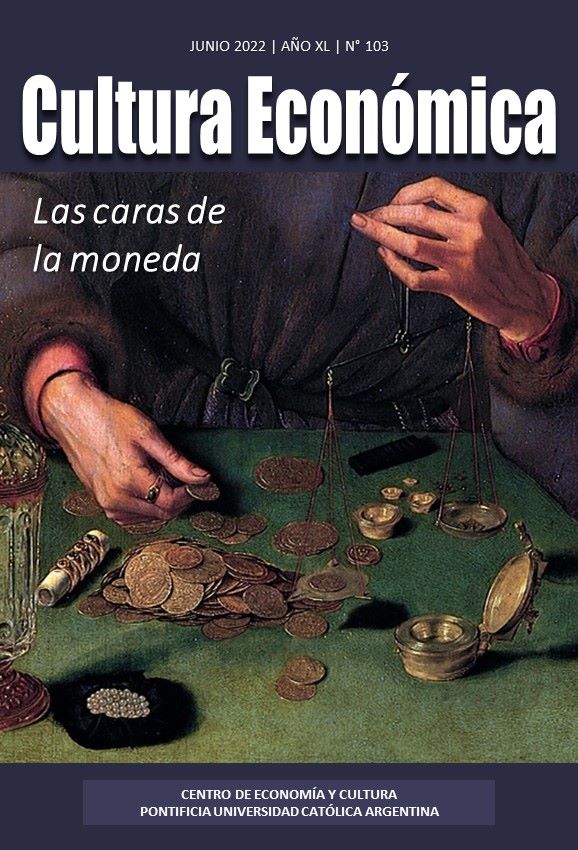Monetary policy: theory, international history and applications in Argentina
DOI:
https://doi.org/10.46553/cecon.40.103.2022.p39-76Keywords:
BUSINESS FLUCTUATIONS, CYCLES, MONETARY SYSTEMS, STANDARDS, REGIMES, GOVERNMENT AND THE MONETARY SYSTEM, PAYMENT SYSTEMS, MONETARY POLICY, CENTRAL BANKS AND THEIR POLICIESAbstract
Historically, money has always occupied a central place in economic theory. The perception of its role and its influence have changed over time and, although there is quite general consensus, it is still controversial today. Monetary policy, that is, the management of its supply based on several objectives, has also evolved over time along theoretical advances and historical situations. In this article, I intend to review how the criteria that govern its actions have changed and the challenges that currently exist at a global level, as well as analyze the evolution of monetary policy in Argentina within that context.Downloads
References
Bajo, O., & Mones, M. A. (2000). Curso de Macroeconomía. Barcelona: Antoni Bosch.
Bank of England (2022). “Interest rates and Bank Rate”. Bank of England. https://www.bankofengland.co.uk/monetary-policy/the-interest-rate-bank-rate Último acceso: mayo 2022.
Bank of Japan (2022). “Monetary Policy Releases”. Bank of Japan. https://www.boj.or.jp/en/mopo/mpmdeci/index.htm/ Último acceso: mayo 2022.
Barro, R. J., & Gordon, D. B. (1983). “Rules, discretion, and reputation in a model of monetary policy”. NBER Working Paper 1079, National Bureau of Economic Research.
Board of Governors of the Federal Reserve System (2022). “FOMC Materials”. Board of Governors of the Federal Reserve System.
https://www.federalreserve.gov/monetarypolicy/materials/ Último acceso: mayo 2022.
Buera, F., & Nicolini, J. P. (2022). “The History of Argentina”. In Kehoe, T. J., & Nicolini, J. P. (eds.). A monetary and fiscal history of Latin America, 1960-2017. Minneapolis: University of Minnesota. https://manifold.bfi.uchicago.edu/read/5d1647e2-9986-4d25-968b-118d55d4d111/section/4fb09bf3-b545-4f6f-91f3-76f3d201b15a#ch03. Ultimo acceso: mayo 2022.
Calvo Bernardino, A., Fernández Díaz, A., Galindo Martín, M. A., Parejo Gamir, J. A., & Rodríguez Sáir, L (2003). Política monetaria I: fundamentos y estrategias. Madrid: Thomson.
Cortés Conde, R. (1997). La economía argentina en el largo plazo. Buenos Aires: Editorial Sudamericana.
Cortés Conde, R. (2007). Historia económica mundial (3ª edición). Buenos Aires: Ariel.
D’Amato, L., & Ortiz Batalla, J. (2020). “Política monetaria y bancaria: el Banco Central y el sistema financiero durante el primer peronismo”. En Cortés Conde, R., Ortiz Batalla, J., D’Amato, L., & Della Paolera, G. (eds.) (2020). La economía de Perón. Ciudad Autónoma de Buenos Aires: Edhasa.
Dell'Ariccia, G., Rabanal, P., & Sandri, D. (2018). “Unconventional Monetary Policies in the Euro Area, Japan, and the United Kingdom”. Journal of Economic Perspectives, 32(4), 147-72.
Dimand, R. (2013). “David Hume and Irving Fisher on the quantity theory of money in the long run and the short run”. The European Journal of the History of Economic Thought, 20(2), 284-304.
Dimand, R., & Gomez Betancourt, R. (2012). “Retrospectives: Irving Fisher's Appreciation and Interest (1896) and the Fisher Relation”. Journal of Economic Perspectives, 26(4), 185-96.
European Central Bank (2022). “Key ECB interest rates”. European Central Bank. https://www.ecb.europa.eu/stats/policy_and_exchange_rates/key_ecb_interest_rates/html/index.en.html Último acceso: mayo 2022.
FMI (2021). “Annual report on exchange arrangements and exchange restrictions 2020”.
FMI (2022). “World economic outlook database”. https://www.imf.org/en/Publications/WEO/weo-database/2022/April Último acceso: mayo 2022.
FRED (s.f.). “FRED. Economic data”. Economic Research. Federal Reserve Bank of St. Louis. https://fred.stlouisfed.org/ Último acceso: mayo 2022.
Friedman, M. (1968). “The role of monetary policy”. The American Economic Review, 58(1), 1–17.
Gerchunoff, P., & Llach, L. (2018). El ciclo de la ilusión y el desencanto. Ciudad Autónoma de Buenos Aires: Crítica.
Grillo, F., Katz, S., & Machinea, J. L. (2020). “Impulso expansivo, redistributivo e industrializador: la política fiscal bajo el peronismo”. En Cortés Conde, R., Ortiz Batalla, J., D’Amato, L., & Della Paolera, G. (eds) (2020). La economía de Perón. Ciudad Autónoma de Buenos Aires: Edhasa.
Hume, D. (1752). “Of money”. https://davidhume.org/texts/pld/mo Último acceso: mayo 2022.
Keynes, J. M. (1992). Teoría general de la ocupación, el interés y el dinero (2ª edición). Buenos Aires: Fondo de Cultura Económica de Argentina.
Kuttner, K. (2018). “Outside the Box: Unconventional Monetary Policy in the Great Recession and Beyond”. Journal of Economic Perspectives, 32 (4), 121-46.
Laidler, D. (1977). La demanda de dinero. Barcelona: Antoni Bosch.
Lagos, M., Llach, J. J., Fracchia, E., & Marull, F. (2011). Claves del retraso y del progreso de la Argentina. Buenos Aires: Temas Grupo Editorial.
Leijonhufvud, A. (1992). “Keynesian economics: past confusions and future prospects”. En Vercelli, A., & Dimitri, N. (eds.) (1992). Macroeconomics: A survey of research strategies. Oxford: Oxford University Press.
Lucas, R. E. (1973). “Some international evidence on output-inflation tradeoffs”. The American Economic Review, 63(3), 326–34.
Lucas, R. E. (1976). “Econometric policy evaluation: A critique”. Carnegie-Rochester Conference Series on Public Policy, Vol. 1, 19-46.
Lucas, R. E. (1995). “Monetary neutrality”. Nobel Prize Lecture.
Mankiw, N. G., & Reis, R. (2018). “Friedman’s presidential address in the evolution of macroeconomic thought”. Journal of Economic Perspectives, 32(1), 81-96.
Randall, L. (1978). Historia económica de la Argentina en el siglo XX. Buenos Aires: Amorrortu editores.
Samuelson, P. A., & Solow, R. M. (1960). “Analytical aspects of anti-inflation policy”. The American Economic Review, 50(2), 177–194.
Downloads
Published
How to Cite
Issue
Section
License












